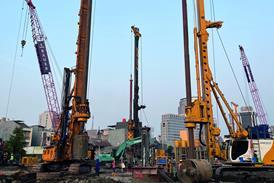Those named and blamed in Sir Martin Moore-Bick鈥檚 report largely got what they deserved, but they were not alone in the way they operated. We may have learnt and changed since 2017, but there is still a long way to go, says Richard Steer

For everyone who automatically adds the word 鈥渃owboy鈥� to the word 鈥渂uilder鈥�, phase two of the Grenfell report no doubt endorsed existing feelings of disgust, mistrust and annoyance. What other industry has been the subject of an outside, third-party review that used words like 鈥渇ailure鈥�, 鈥渟lapdash鈥� and 鈥渄ishonest鈥� to describe its work?
The disgusting thing is that, looking back at 2017, the view expressed by Sir Martin Moore-Bick and his colleagues is correct in that 72 people died in a raging inferno that could and should have been prevented by a robust inspection process, a disciplined approach to construction and an ethos that placed pride above profit and safety above cynicism. Now I wonder whether we are all tarred with the same broad brush applied by an adjudicator from outside our industry who is justifiably unsparing in his criticism.
>> Also read: Shock and shame: the Grenfell report has exposed construction鈥檚 deadly failures
>> Also read: Seven years after Grenfell, we have come a long way - but there is still a huge amount to do
The question is, where do we go from here, and are the factors that caused Grenfell still present in the sector some seven years on?
One thing is certain: the friends and families of those who died on that wretched night in June 2017 are rightly asking for answers, culpability and closure from those who the report blames for Grenfell.
Many people who own apartments in unsafe buildings still find themselves having to endure burdensome costs to fix them and struggle to hold developers accountable
As a sector we must learn and change and, following Dame Judith Hackitt鈥檚 review of building regulations in 2018, I would argue that our sector did transform. Grenfell-style cladding has been banned on tall buildings and has been removed from many of the hundreds of other high-rises where it was identified. This month, the government announced a complete ban on the use of that cladding on all new buildings and those undergoing repairs, regardless of height or use.
The government has also allocated billions of pounds to fund the removal of unsafe cladding in England, but critics say the funds are largely insufficient and many people who own apartments in unsafe buildings still find themselves having to endure burdensome costs to fix them and struggle to hold developers accountable.
In January, former housing secretary Michael Gove announced plans to overhaul the government鈥檚 approach to building safety across England, and has made moves to ensure that the costs of fixing fire safety issues are shouldered by the developers. This is still work in progress, however.
As of April this year, 1,975 residential buildings have started or completed the remediation of unsafe cladding, accounting for 46% of buildings where a fire risk has been identified, according to what was then the Department for Levelling Up, Housing and Communities. A total of 2,361 buildings are still awaiting safety work, with scores of people living in uncertainty.
So I fully support the calls for a single construction regulator responsible for construction product regulations, testing, fire risk assessor accreditations, building control oversight and the licensing of contractors to work on higher-risk buildings (HRB). One should not underestimate what a massive change this would make as it cuts across several existing departments.
It will take substantive resources to implement, however, and unless we see a new government prepared to adopt the same urgency of approach that was demonstrated once the Post Office scandal was uncovered this year, the whole thing could become mired in a Whitehall bureaucracy which delays and nullifies the recommendations contained in the phase two report.
The light touch supervisory environment encouraged by central government also played its part in the disaster
The proposed national register of contractors for HRBs is another good idea. But, with a shortage of contractors preventing low-risk projects being built, will many step forward when, under the new process suggested, a director has to personally guarantee that the building constructed is as safe as required by the 好色先生TV Regulations? This is a big ask. I am not arguing against it 鈥� I am just wondering if, when good intentions meet the pragmatic realities of our sector, it will work.
It is easy to be myopic and solely place blame for Grenfell at the door of those who built and cladded the tower. However, the light touch supervisory environment encouraged by central government also played its part in the disaster.
I would caution the current government that, as it motors ahead with a desire to build 1.5 million new homes in five years 鈥� or 2,500 homes per month 鈥� it is urgently going to need to fill the 9,000 vacant planning officer roles, plus building control jobs.
More on the Grenfell Inquiry Phase 2 report
Product manufacturers come out fighting after Grenfell Inquiry鈥檚 damning verdict
What the Phase 2 report said about consultants and contractors
Grenfell Inquiry Phase 2 report: all our coverage in one place
Decades of central government failure led to Grenfell tragedy, says inquiry
The development of competence in building safety professionals was a key recommendation of the Hackitt report in 2018. Her suggestion resulted in the creation of a new, protected profession of 鈥渞egistered building inspector鈥�, with the new 好色先生TV Safety Regulator to oversee the register.
Last April, many authoritative bodies including the RICS were arguing that the new system was causing a log-jam. In February, Lorna Stimpson, chief executive of Local Authority 好色先生TV Control, wrote to the government to warn that a 鈥渟ignificant number鈥� of local authorities will be unable to undertake building control services from April unless a deadline to register and achieve certification was extended.
Such was the concern then. It has not been resolved and, while projects are becoming increasingly delayed by the gateway approval process, and the impact of labour shortages on key specialisms such as fire engineering and building control become difficult to navigate, the inquiry report brings the purpose of this generational change in safety standards into sharp focus.
So, what has changed since Grenfell, and were last week鈥檚 criticisms justified? I think, in broad terms, that those who were named and shamed deserved the opprobrium. But I also believe that these were not just rogue firms who set out to destroy the lives of 72 people and their families. Many others operated in the same way, using the same materials at the time.
Moore-Bick and his colleagues, the architect Thouria Istephan and housing expert Ali Akbor, found 鈥渘o simple answer鈥� to the question of why Grenfell happened. I agree. Since then, I think that our sector has learnt. I wish I could say the same of politicians, who are quick to ascribe blame but also keen to cut the costs which safeguard building standards and protect the public.
Richard Steer is chair of Gleeds Worldwide and a 好色先生TV The Future Think Tank commissioner























No comments yet